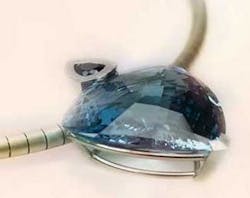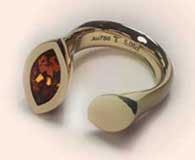Idar-Oberstein, Germany—Heinrich Teigelkötter, a master watchmaker and optician, founded a studio in Werne, Germany, in 1921. His son Heinz took over the company in 1975 and steadily expanded the range of products and moved to new larger premises close by. Between 1990 and 1994, Tobias Teigelkötter, the grandson, trained as a goldsmith and in 1995 he began working with the first manual welding laser for jewelry production from Baasel Lasertech (today ROFIN/Baasel Lasertech). The goldsmith ordered a system for the family enterprise; however this laser did not stay for long, as Tobias opened a jewelry design studio in Idar-Oberstein in 1996 taking the laser with him.
Laser marking of jewelry is the main process performed at the Teigelkötter studio. Laser technology provides all of the benefits of contact-free, abrasion-resistant, and permanent marking for most materials such as platinum, gold, silver, or titanium. Thanks to high speed, ultimate precision, and the possibility of deeper engravings, marking lasers have now replaced diamond engraving at numerous jewelry manufacturers and high street jewelers.
In the Teigelkötter studio, the laser is also used for a wide range of applications. One example of innovation made possible by the use of a Rofin welding laser is a new setting technique that can be used on complicated shapes and does not conceal large areas of the stone. With conventional techniques, securing the setting over the girdle can involve heavy mechanical load on the precious stone, and corners of square stones or shapes that have pointed edges are therefore extremely vulnerable to cracking. By comparison, the laser allows filigree welding of the finest materials very close to heat-sensitive precious stones.
Using laser welding, new types of settings have been developed to secure the stone between two thin sheets (as shown in the cover photo) that have previously been cut for a perfect fit. Having been welded by the laser, the conical edges of the cut fix the Rondiste around the circumference or, alternatively, only at selected points. This concept leaves the rear of the stone completely free, allowing new filigree and transparent jewelry design, particularly for larger stones. The manual welding laser used for setting stones is also used for a wide variety of other applications in jewelry production. The precision of the laser together with the minimal heat input allow the application of claw settings directly onto the stone. Tobias Teigelkötter does all of the fixings prior to soldering. One or two spot welds tack the pieces together, much better than any other joining technique.
The laser also does the marking for all bevel settings just as for the two sheets forming the laser welded setting. For this purpose, the stone is scanned, and the contours are verified. These parameters make the inner and outer contour lines for the setting.
Tobias Teigelkötter fills any spare capacity on his marking lasers with job shop orders—often for local shops, for example for personalizing high-value hunting knives made of specific steel which are difficult to mark with conventional engraving methods. Or he may do some more research work looking for other new and interesting applications for the laser.
Tobias uses Rofin’s EasyJewel, the compact and cost-effective jewelry laser marker, to achieve these perfect results. This system, specifically designed for marking precious metal, in the hands of someone such as Tobias, who has so much knowledge about the craftsmanship of stone engraving and laser technology, makes possible new applications.
It is not only the performance and excellent beam quality, required for efficient and high-quality processing of precious metals, but also the sophisticated all-in-one solution offered by EasyJewel that has made this system the first choice of many jewelry manufacturers and up-scale jewelers.

